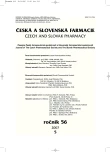Effect of vanadium compounds on the growth and production of coumarins in the suspension culture of Angelica archangelica L.
Authors:
T. Siatka; M. Kašparová
Authors‘ workplace:
Katedra farmakognozie Farmaceutické fakulty Univerzity Karlovy, Hradec Králové
Published in:
Čes. slov. Farm., 2007; 56, 230-234
Category:
Original Articles
Overview
Plant tissue cultures represent a promising source of substances of natural origin. The main problem of their use is a low production of the majority of secondary metabolites. One of the methods of increasing the production of these substances is elicitation, because the biosynthesis of many secondary metabolites in plant cells is part of the defensive reaction against biological or abiotic stress influences. The paper tested vanadium compounds as potential elicitors of the production of coumarins: sodium vanadate (0.2; 1; 10; 100 and 1000 μM/l of medium) and vanadyl sulfate (10; 20; 50; 100; 200 and 500 μM/l of medium). The toxicity of these substances for the culture was simultaneously monitored by means of the evaluation of the effects on growth (characterized by fresh and dry weights of biomass at the end of two-week cultivation). The cultures were grown both in the light and dark. The growth of the cultures was not influenced by sodium vanadate at concentrations of 0.2 to 100 μM. A vanadate concentration of 1000 μM acted already toxically (in comparison with the control culture, the fresh weight was decreased by 28 % and the dry weight by 41 % when cultivated in the light; the fresh weight by 69 % and the dry weight by 66 % when cultivated in the dark). Vanadyl sulfate in concentrations of 10 to 50 μM did not affect the growth of the culture, at higher concentrations it decreased it gradually; a concentration of 500 μM acted already toxically, again more markedly when cultivated in the light (in comparison with the control culture, the fresh weight was decreased by 27 % and dry weight by 38 % when cultivated in the light; the fresh weight by 65 % and the dry weight by 61 % when cultivated in the dark). The production of coumarins was stimulated by sodium vanadate in a concentration of 0.2 and 1 μM when cultivated in the light. The content of coumarins increased in comparison with the control culture mainly in the medium by 46 % and by 25 % at vanadate concentrations of 0.2 and 1 μM, respectively. Vanadyl sulfate did not increase the production of coumarins.
Key words:
Angelica archangelica L. – suspension culture – growth – coumarins production – vanadium – toxicity – vanadate –vanadyl sulfate
Labels
Pharmacy Clinical pharmacologyArticle was published in
Czech and Slovak Pharmacy

2007 Issue 5
Most read in this issue
- Mucoadhesive tablets for oral administration of ciclopiroxolamine
- Cytochrome P450 3A polymorphism and its importance in cyclosporine and tacrolimus therapy in transplanted patients
- Oxidative stress and its role in respiratory diseases
- Determination of valproic acid by on-line coupled capillary isotachophoresis with capillary zone electrophoresis with conductometric detection
